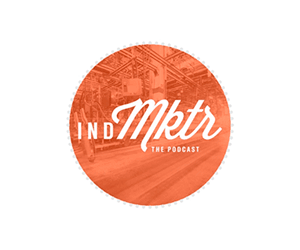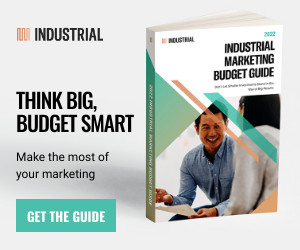The industrial buying journey has changed significantly in recent years, shaking up the buyer’s awareness stage, the consideration phase, and the decision-making process. The pandemic was a black swan event that accelerated the evolution from trade shows and personal sales networks to a digital-based approach that involves buying committees and an elongated, non-linear process.
Consider this recent summary of the industrial buying journey from Cadenas Parts Solutions:
- Industrial buyers analyze products closely, evaluate products based on measurable specs and ROI, but their engineers rarely make final purchase decisions (and those final decision makers rarely talk with the sales teams for the product)
- Products are so niche that statistical market research methods generally do not work
- From first contact to sale, the sales journey can take years
This dynamic has made the middle of the marketing funnel more crucial in industrial marketing than in many other B2B segments. Quality leads trump quantity, and discovering intent is like finding a key to a vault of opportunity. With that in mind, in this episode of the Industrial Marketer podcast, Joey and Nels offer up 10 things to consider in the consideration phase of the industrial buying phase.
1. What Is the Consideration Phase?
The consideration phase is traditionally defined as the stage when a prospect already knows your product or service is a viable resolution option to their problem, and they are evaluating it among possible solutions. In the realities of the industrial buying process, the consideration phase quickly gets into the weeds of product data. It’s all about the customer experience.
2. Who Is Involved in the Consideration Phase?
The trend in industrial buying journeys is toward “buying committees.” According to Gartner, “the typical buying group for a complex B2B solution involves 6 to 10 decision makers;” and each of these buying committee members comes with their own perspectives, backgrounds, biases, needs, and goals that must be addressed in order to push a decision forward. Yikes; that makes the task sound daunting. Yes, it is. You must think beyond the original source of your lead to create materials and campaigns that generate engagement, address concerns, and affirm decisions with the entire buying committee. An industrial buying committee might include:
- Point person – The person doing the primary research, such as an engineer director, operations manager or facility manager.
- Point person’s team members – These could include peers and direct reports in engineering, facilities and procurement.
- Point person’s direct manager – This often is the decision maker, who could be a VP of operations, a CEO or CFO in larger organizations, or the owner in many manufacturing companies.
3. What Information Do You Need from the Awareness Stage?
This is an internal-facing concern. You should be able to establish engagement milestones, most of which you can automate. The most obvious answer is that your lead scoring tells you when a prospect has had enough “top of the funnel” engagement to reach this stage. But engagement from a known contact or lost customer might qualify as well.
4. What Questions Do You Need to Answer?
This is an external-facing concern. You want these prospects to know your products and services and can expect that they will know those of your competitors. Many buyers use their first product evaluation to establish expectations for capabilities and price, which is why you want to be their initial contact during the consideration phase.
Pricing is a big deal at this stage. Consider this stat from Gartner research on sales behavior: “Manufacturing buyers want to engage with suppliers through user-friendly online ordering features, even with custom products. Some 64 percent state that they would switch to another vendor if the company provides real-time, personalized pricing.”
5. How Long Should the Consideration Phase Be?
This will vary wildly based on industry and client needs. There is no clear answer beyond “as long as it takes.” But one suggestion is to add touch points to check in throughout this phase, because out of sight equals out of mind.
One sales tip for when a prospect has seemingly lost momentum or interest: Offer to end the pursuit. Send a re-engagement email acknowledging the current inactive status and ask if the prospect wants you to leave them alone. If they say yes, you are no longer wasting anyone’s time. But you might be surprised how often it kick starts the process.
6. What Content Pieces Should Be Created?
Provide whatever information the prospect needs to do comparative shopping. Another way to look at this is to produce a digital version of whatever you would show off at a trade show:
- 3D renders
- CAD models with embedded data
- Videos of use cases
- Spec sheets for all configurations
- Case studies
Again, think about the customer experience. What would you want to see if you were in their shoes?
7. What Channels Should You Use?
This is where your CRM software can pay big dividends. Do you know where your best customers have found this product or where they first engaged with you?
It certainly could be via a Google search, but it also could be trade journals or a peer review site like G2 or Capterra. And channels will vary for each member of the buying committee, making the task even more difficult.
8. How Can You Differentiate Yourself from Competitors?
If your first instinct is that you should be differentiating yourself from the competitor at every stage, you are correct. During the consideration phase, your target audience already is in evaluation mode, so you are not educating them on what your product or service does, but how it achieves success. What makes your product or service so special? You can do this with comparisons of competitor attributes such as quality, efficiency, price, and service. You can also do this by educating them on what it does not do. One of the goals of this phase is to weed out the people who are not likely to buy your product.
9. What Keywords Should You Consider?
Remember that you are not trying to win over the masses during the consideration phase. It’s more about your niche searches. Generic keywords like “metal fabrication” or “artificial intelligence” are not keywords to focus on during the consideration phase. Take the next step by identifying the problems your audiences are trying to solve, placing yourself in a position to be considered as a solution to those problems, like:
- “metal fabrication for processing plant ductwork”
- “best manufacturing artificial intelligence tools”
- “how to implement cybersecurity at metal fabricator”
10. What Happens Next?
The consideration phase is about answering prospects’ questions and building trust and confidence in your products and services. And while you can’t be too pushy with sales offers at this stage, you have been nurturing prospects with a sales offer in mind. So, the final step of the consideration stage is purposeful nurturing of a lead into the decision phase.
You can nudge a prospect into the decision making phase with downloadable content, webinars, testimonials, and case studies, but the best method will vary based on your sales process. Email marketing and retargeting ads work well in this stage to be able to surround a prospect with specific messaging about their problems and how you can act as a solution.
Consider the Consideration Phase as a Chance to Lean More about Prospects
The foundation for the consideration phase is a great customer experience. Help them however you can. The consideration phase can be a bit confounding, much like the industrial buying journey in general. But the good news is that the consideration phase often takes much longer than the purchase phase, which means that if you can get it right, you’ll set yourself up for success.
You also might want to consider building in an account-based marketing methodology as well. If four people from the same company have been checking out your products and services, what is the best action for your company to take? The consideration phase is a great opportunity to learn more about prospects as they engage with content, so having the tools in place to monitor those activities across key accounts can be a game-changer for many companies.
Listen to the Podcast for More on the Consideration Phase
For more insights into the industrial marketing consideration phase, tune into Episode 30 of the Industrial Marketer podcast.
Subscribe to the Industrial Marketer Podcast
The Industrial Marketer podcast comes out twice a month. To subscribe, visit our Buzzsprout show page and select your podcast platform of choice.
And if you have any ideas for topics you’d like us to cover on the podcast — or here on the Industrial Marketer website — send us a message on Facebook or Twitter and let us know!




